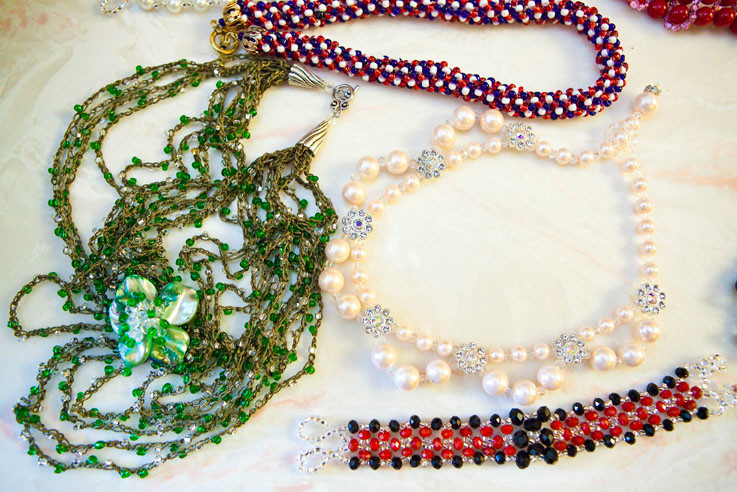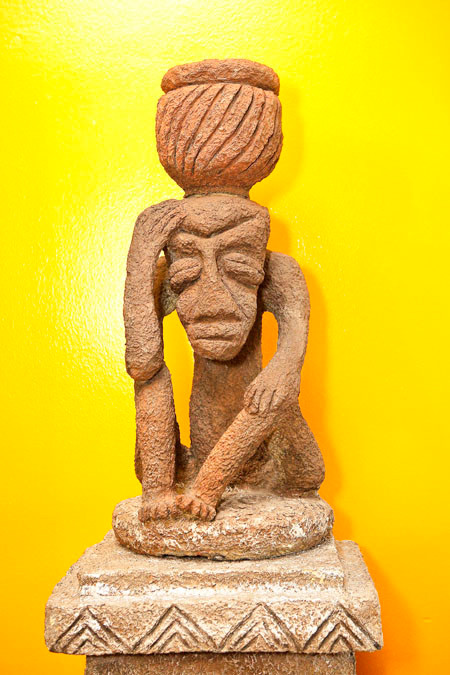Multi-talented teacher brings art to all she does
Each time Mercedes Polanco, 58, molds dirt into textured drinking jugs, rolls cornmeal into dolls, or crafts sculptures of shamans out of phone books, the Dominican Republic’s first artwork is reincarnated.
Ms. Polanco, an internationally recognized artisan, says her pieces build on the legacy of the Taíno people who carved, painted and sculpted gods into the landscape of her native Dominican Republic long before Spaniards sailed to the Caribbean. The Cemi, more than 80 Gods revered by the Taínos, cover the four-foot tall papier mache sculptures, bangles and island maps in Ms. Polanco’s Bailey Avenue apartment.
“This is our origins. When Columbus showed up to the islands this is what they found existed there: our art, our culture. This is what you see written on the walls of caves in the Dominican Republic,” Ms. Polanco said in Spanish. “I do it creatively, but I’m not inventing anything.”
The orange walls of Ms. Polanco’s apartment are covered with dozens of Taíno symbols. Above her leather coach, dozens of symbols for gods, including a sun, fish skeleton, monkey and mask mark a beige, gold and brown map of the Dominican Republic and Haiti. Shelves full of sculpted water jugs rest behind her kitchen table. And near the kitchen, hundreds of jewelry pieces are showcased under the glass layer of her office desk. Though there are no walls, Ms. Polanco said her young niece and nephew pretend to knock or ring a bell near the corner where she works, seated at a leopard-print chair stitched into the shape of a high heel.
She said she began studying Taíno heritage and mythology in America and keeps a nearly 1,000-page book full of symbols and stories in her apartment for reference.
Ms. Polanco chides merchants across the Caribbean for altering symbols by adding tails, heads or ears to deities to make them more attractive to tourists.
“The youth, they come here and they don’t know because in school they talk about it in very superficial ways,” Ms. Polanco said in Spanish. “My kids’ friends came here and they tell the kids, ‘How can you sleep here in this place with all these monsters and things?’ So I sit down and explain to them this is what our ancestors did …”
Ms. Polanco said she’s felt connected to the Taíno ever since her grandmother showed her a figurine crafted out of “barro” or dirt, buried in her yard.
Her interest in art also came from childhood. It was only after she learned handcrafts from her grandmother and mother that Ms. Polanco formally studied ceramics in Santo Domingo.
When she immigrated to New York 18 years ago, Ms. Polanco said she began experimenting with new mediums because the expense of renting a ceramic oven and studio space was too great. Soon she was teaching at Alianza Dominicana, a New York City non-profit that provides medical, cultural and educational services. She taught students how to craft dolls and figurines, bead jewelry, make candles, mold paper mache and create three-dimensional pop-up style pieces.
Ms. Polanco studied journalism through the Institute of Dominican Journalism in New York, which she said helped her launch the magazine featuring profiles and news about artisans in New York and the Caribbean in 2006.
Dominicano Artesanal, a bi-annual magazine that she runs out of her apartment, is dedicated to those who make “manual art” across the Caribbean and Eastern United States.
The free publication includes photos of brightly painted cornmeal dolls, masks and other crafts, articles from correspondents in the Dominican Republic and paid advertisements.
“I thought, if baseball players can have a magazine; if actors can have a magazine; why can’t artisans have a magazine?” Ms. Polanco said in Spanish. “So I went to study.”
Her work has caught the attention of Despierte América, a morning show in Spanish broadcast across America, the Caribbean and parts of Latin America, as well as dozens of New York City publications.
Education remains a core part of Ms. Polanco’s work. At one point, Ms. Polanco taught at six schools in the area. For the past six years, she said she’s focused primarily on her business Taller Artesania Yanimark, which combines the names of her children Marco and Janeli.
But she couldn’t give up teaching entirely.
She instructs parents at IN-Tech Academy, MS/HS 368, in jewelry making as part of the school’s community and adult education program.
Students like Ingrid Amparo say Ms. Polanco inspired her to acquire more skills and eventually open her own business, a flower and decoration shop. Ms. Amparo said her sister, who also took Ms. Polanco’s classes at Alanzia Dominicana, continues to use techniques she learned in Ms. Polanco’s class: beading jewelry and make figurines by dying cornmeal dough, layering it into dolls with dresses and flowers and letting it harden in the sun.
“She is an excellent, excellent professor. She would stay extra hours, even though she wasn’t getting paid, because she explained stuff to the maximum,” Ms. Amparo said in Spanish. “She taught me those thing and it helped me expand and open my mind to other things, like opening a business.”
Currently, Ms. Polanco says she’s compiling a collection of what she’s learned as an artisan into a book. She described it as a “motivational” handbook filled with parables like, “Money only destroys those that don’t have morals,” and “Maintain dignity in everything you do in your life.”
She hopes an editor finishes reviewing the book in time for the Sixth Annual Dominican Book Fair in New York at the end of September. Though Ms. Polanco has helped organize the artists’ section of the fair for years, this would be the first time she brings books along with beaded bracelets woven into floral patterns, hemp necklaces and hand-made rosaries.
— Reporting contributed by Marisol Díaz











